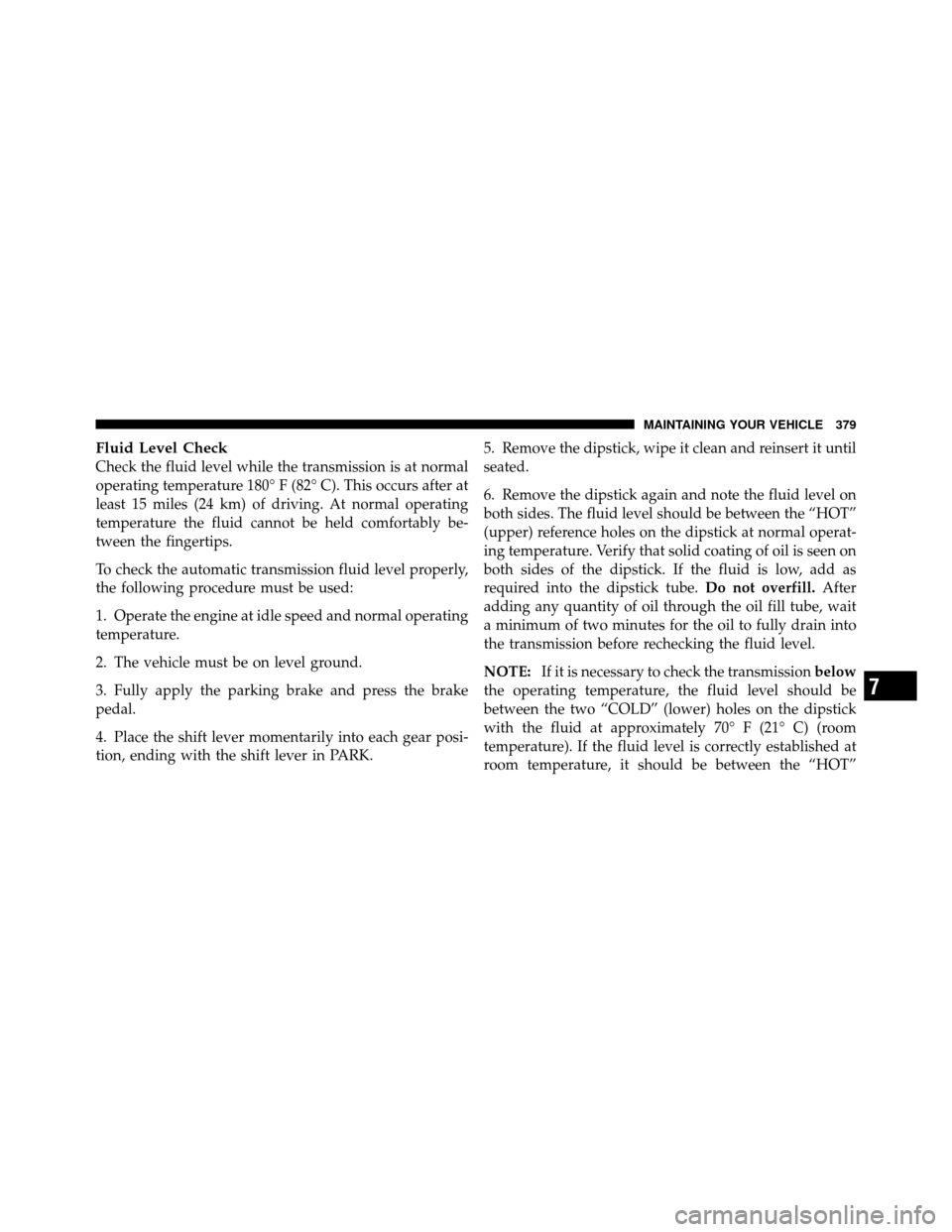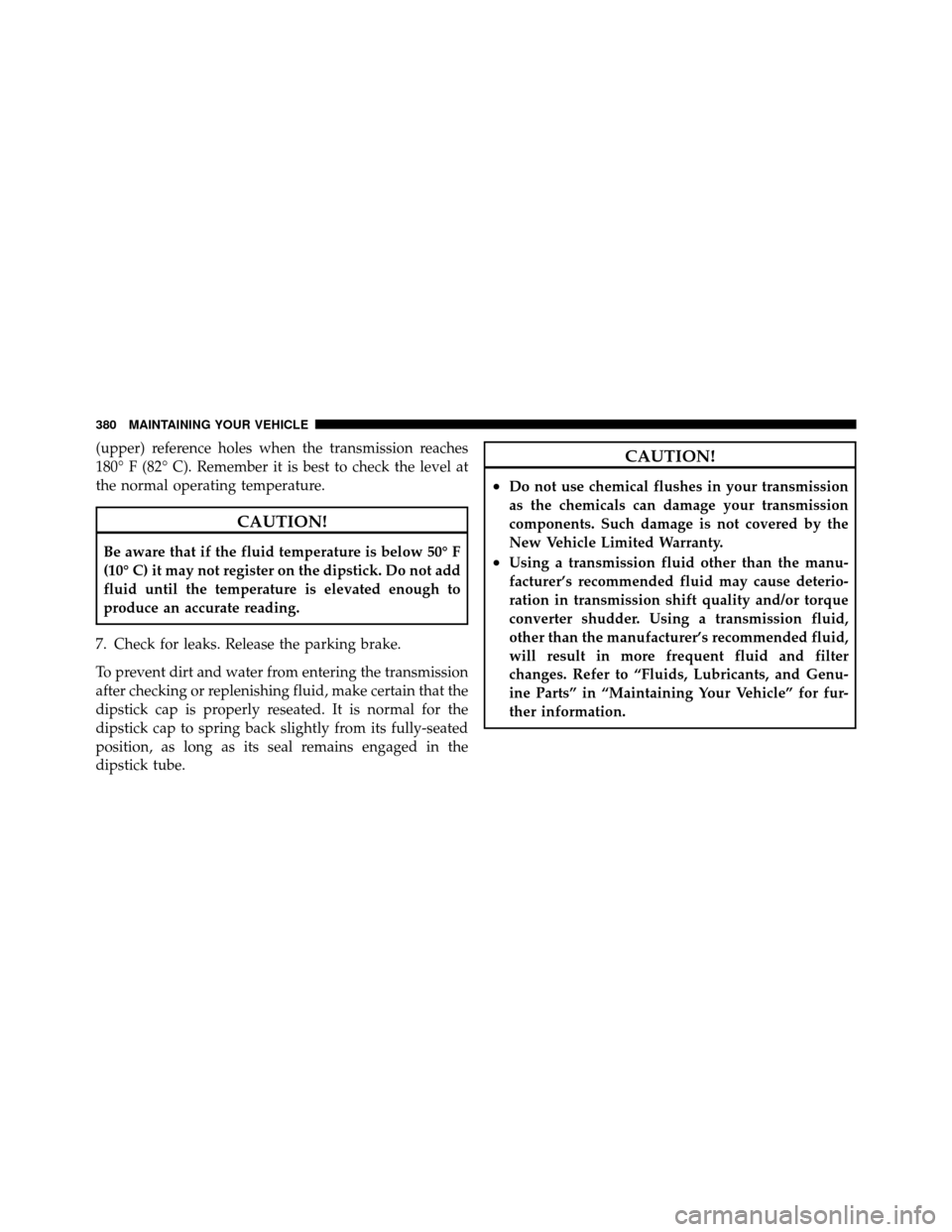2011 DODGE DAKOTA check transmission fluid
[x] Cancel search: check transmission fluidPage 329 of 452

NOTE:Check the automatic transmission fluid level
before towing.
Tow/Haul – If Equipped
To reduce potential for automatic transmission overheat-
ing, turn the TOW/HAUL feature ON when driving in
hilly areas or shift the transmission to Drive position 2 on
more severe grades.
Electronic Speed Control – If Equipped
�
Do not use in hilly terrain or with heavy loads.
�When using the speed control, if you experience speed
drops greater than 10 mph (16 km/h), disengage until
you can resume cruising speed.
�Use speed control in flat terrain and with light loads to
maximize fuel efficiency.
Cooling System
To reduce potential for engine and transmission over-
heating, take the following actions:
�City Driving
When stopped for short periods of time, shift the trans-
mission into NEUTRAL and increase engine idle speed.
�Highway Driving
Reduce speed.
�Air Conditioning
Turn off temporarily.
SNOWPLOW
Snow plows, winches, and other aftermarket equipment
should notbe added to the front end of your vehicle. The
airbag crash sensors may be affected by the change in the
front end structure. The airbags could deploy unexpect-
edly or could fail to deploy during a collision.
5
STARTING AND OPERATING 327
Page 363 of 452

CAUTION! (Continued)
•Your vehicle has been built with improved fluids
that protect the performance and durability of
your vehicle and also allow extended maintenance
intervals. Do not use chemical flushes in these
components as the chemicals can damage your
engine, transmission, power steering or air condi-
tioning. Such damage is not covered by the New
Vehicle Limited Warranty. If a flush is needed
because of component malfunction, use only the
specified fluid for the flushing procedure.
Engine Oil
Checking Oil Level
To assure proper lubrication of your vehicle’s engine, the
engine oil must be maintained at the correct level. The
best time to check the engine oil level is about five
minutes after a fully warmed-up engine is shut off.Checking the oil while the vehicle is on level ground will
improve the accuracy of the oil level readings. Always
maintain the oil level within the SAFE zone on the
dipstick. Adding one quart/liter of oil when the reading
is at the bottom of the SAFE zone will result in a reading
at the top of the safe zone on these engines.
CAUTION!
Overfilling or underfilling the crankcase will cause
oil aeration or loss of oil pressure. This could damage
your engine.
Change Engine Oil
The oil change indicator system will remind you that it is
time to take your vehicle in for scheduled maintenance.
Refer to the “Maintenance Schedule” for further informa-
tion.7
MAINTAINING YOUR VEHICLE 361
Page 381 of 452

Fluid Level Check
Check the fluid level while the transmission is at normal
operating temperature 180° F (82° C). This occurs after at
least 15 miles (24 km) of driving. At normal operating
temperature the fluid cannot be held comfortably be-
tween the fingertips.
To check the automatic transmission fluid level properly,
the following procedure must be used:
1. Operate the engine at idle speed and normal operating
temperature.
2. The vehicle must be on level ground.
3. Fully apply the parking brake and press the brake
pedal.
4. Place the shift lever momentarily into each gear posi-
tion, ending with the shift lever in PARK.5. Remove the dipstick, wipe it clean and reinsert it until
seated.
6. Remove the dipstick again and note the fluid level on
both sides. The fluid level should be between the “HOT”
(upper) reference holes on the dipstick at normal operat-
ing temperature. Verify that solid coating of oil is seen on
both sides of the dipstick. If the fluid is low, add as
required into the dipstick tube.
Do not overfill.After
adding any quantity of oil through the oil fill tube, wait
a minimum of two minutes for the oil to fully drain into
the transmission before rechecking the fluid level.
NOTE: If it is necessary to check the transmission below
the operating temperature, the fluid level should be
between the two “COLD” (lower) holes on the dipstick
with the fluid at approximately 70° F (21° C) (room
temperature). If the fluid level is correctly established at
room temperature, it should be between the “HOT”
7
MAINTAINING YOUR VEHICLE 379
Page 382 of 452

(upper) reference holes when the transmission reaches
180° F (82° C). Remember it is best to check the level at
the normal operating temperature.
CAUTION!
Be aware that if the fluid temperature is below 50° F
(10° C) it may not register on the dipstick. Do not add
fluid until the temperature is elevated enough to
produce an accurate reading.
7. Check for leaks. Release the parking brake.
To prevent dirt and water from entering the transmission
after checking or replenishing fluid, make certain that the
dipstick cap is properly reseated. It is normal for the
dipstick cap to spring back slightly from its fully-seated
position, as long as its seal remains engaged in the
dipstick tube.
CAUTION!
•Do not use chemical flushes in your transmission
as the chemicals can damage your transmission
components. Such damage is not covered by the
New Vehicle Limited Warranty.
•Using a transmission fluid other than the manu-
facturer’s recommended fluid may cause deterio-
ration in transmission shift quality and/or torque
converter shudder. Using a transmission fluid,
other than the manufacturer’s recommended fluid,
will result in more frequent fluid and filter
changes. Refer to “Fluids, Lubricants, and Genu-
ine Parts” in “Maintaining Your Vehicle” for fur-
ther information.
380 MAINTAINING YOUR VEHICLE
Page 409 of 452

Your authorized dealer will reset the oil change indicator
message after completing the scheduled oil change. If a
scheduled oil change is performed by someone other
than your authorized dealer, the message can be reset by
referring to the steps described under “Electronic Vehicle
Information Center (EVIC)/Oil Change Required” in
“Understanding Your Instrument Panel” or under “In-
strument Cluster Description/Odometer/Trip Odom-
eter” in “Understanding Your Instrument Panel” for
further information.
At Each Stop For Fuel
•Check the engine oil level about five minutes after a
fully warmed engine is shut off. Checking the oil level
while the vehicle is on level ground will improve the
accuracy of the oil level reading. Add oil only when
the level is at or below the ADD or MIN mark.
•Check the windshield washer solvent and add if
required.
Once A Month
•Check tire pressure and look for unusual wear or
damage.
•Inspect the battery, and clean and tighten the terminals
as required.
•Check the fluid levels of the coolant reservoir, brake
master cylinder, and transmission, and add as needed.
•Check all lights and other electrical items for correct
operation.
8
M A I
N T
E
N A
N CE
S
C
H E
D
U L
E
SMAINTENANCE SCHEDULES 407
Page 434 of 452

Adding Engine Coolant (Antifreeze).......... 373
Adding Fuel ........................... 310
Air Cleaner, Engine (Engine Air Cleaner Filter) . . . 363
Air Conditioner Maintenance ............... 366
Air Conditioning ........................ 238
Air Conditioning Refrigerant .............366,367
Air Conditioning System ................238,366
Air Conditioning, Operating Tips ..........238,241
Air Filter .............................. 363
Air Pressure, Tires ....................... 285
Airbag ........................... 51,58,190
Airbag Deployment ....................... 59
Airbag Light ........................ 57,61,78
Airbag Maintenance ....................... 60
Airbag, Side .......................... 55,58
Airbag, Window (Side Curtain) ...........54,55,58
Alarm (Security Alarm) .................18,181
Alarm System (Security Alarm) ............... 18
Alarm, Panic ............................ 23 Alterations/Modifications, Vehicle
............. 7
Antenna, Satellite Radio ................208,232
Anti-Lock Brake System (ABS) .............. 273
Anti-Lock Warning Light .................. 181
Anti-Theft Security Alarm (Theft Alarm) ........ 18
Anti-Theft System ..................... 18,181
Antifreeze (Engine Coolant) ..............372,401
Disposal ........................... 374
Appearance Care ........................ 382
Assistance Towing ....................... 102
Auto Unlock, Doors ....................... 31
Automatic Dimming Mirror ................. 86
Automatic Door Locks ..................... 29
Automatic Transaxle .................... 12,252
Interlock System ...................... 15
Automatic Transmission .............249,253,378
Adding Fluid ....................... 379
Fluid Level Check .................... 379
Fluid Type ......................... 403
432 INDEX
Page 435 of 452

Gear Ranges........................ 253
Special Additives ..................... 378
Torque Converter .................... 257
Axle Fluid ............................. 403
Axle Lubrication (Axle Fluid) ............... 381
B-Pillar Location ........................ 280
Battery ............................... 364
Keyless Transmitter Replacement (RKE) ..... 24
Saving Feature (Protection) .............. 138
Belts, Seat ............................ 39,78
Body Mechanism Lubrication ............... 367
Brake Fluid ............................ 403
Brake System ........................ 273,376
Anti-Lock (ABS) ..................... 273
Fluid Check ........................ 376
Master Cylinder ..................... 376
Parking ........................... 271
Warning Light .................... 181,186Brake/Transmission Interlock
............... 253
Break-In Recommendations, New Vehicle ........ 75
Bulb Replacement ....................... 392
Bulbs, Light .......................... 80,392
Calibration, Compass ..................... 152
Camper ............................... 170
Capacities, Fluid ........................ 401
Caps, Filler Oil (Engine) ........................ 362
Power Steering ...................... 270
Radiator (Coolant Pressure) ............. 374
Car Washes ............................ 383
Carbon Monoxide Warning ............77,171,305
Cargo (Vehicle Loading) ................... 312
Cargo Light ............................ 139
Cellular Phone ........................ 88,238
Center High Mounted Stop Light ............ 397
Certification Label ....................... 312
10
INDEX 433
Page 439 of 452

Floor Console.......................... 165
Fluid Capacities ......................... 401
Fluid Leaks ............................. 80
Fluid Level Checks Automatic Transmission ................ 379
Brake ............................. 376
Engine Oil ......................... 361
Power Steering ...................... 270
Transfer Case ....................... 381
Fluid, Brake ........................... 403
Fluids, Lubricants and Genuine Parts .......... 402
Fog Lights .......................... 135,401
Four Wheel Drive ....................... 258
Operation .......................... 258
Four-Way Hazard Flasher .................. 334
Freeing A Stuck Vehicle ................... 349
Front Axle (Differential) ................... 381
Fuel ................................. 301
Adding ........................... 310 Ethanol
........................... 302
Gauge ............................ 179
Methanol .......................... 302
Octane Rating .................... 301,402
Requirements .................... 301,401
Tank Capacity ....................... 401
Fuel, Flexible ........................... 306
Fueling ............................... 310
Fuses ................................ 387
Garage Door Opener (HomeLink®) ........... 153
Gas Cap (Fuel Filler Cap) ............310,311,357
Gas Gauge (Fuel Gauge) ................... 179
Gasoline (Fuel) ......................... 301
Gasoline, Reformulated ................... 302
Gauges Coolant Temperature .................. 179
Fuel .............................. 179
Odometer ....................... 182,183
10
INDEX 437